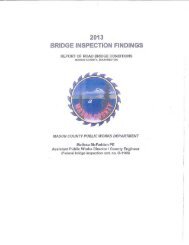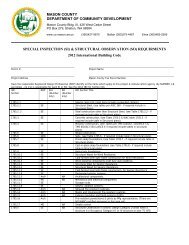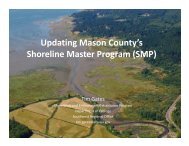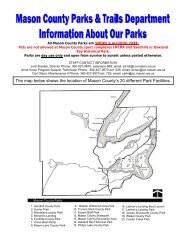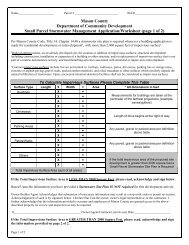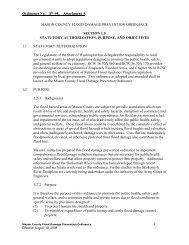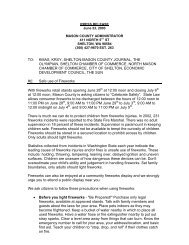Watershed Management Plan - Mason County
Watershed Management Plan - Mason County
Watershed Management Plan - Mason County
You also want an ePaper? Increase the reach of your titles
YUMPU automatically turns print PDFs into web optimized ePapers that Google loves.
Chapter<br />
2 WRIA 16 – State of the <strong>Watershed</strong><br />
draining into the Canal is an issue in areas of dense development which<br />
contain more impervious surfaces from which stormwater can enter the<br />
Canal.<br />
High stream temperatures have been recorded in Dosewallips River,<br />
Marple Creek, Rocky Brook, Duckabush River, Lebar Creek, the South<br />
Fork of the Skokomish River, and Fulton Creek. Cool water is important<br />
for the health and survival of fish and other aquatic communities.<br />
Temperature changes can affect the development, growth, migration, and<br />
risk of disease in fish, especially salmon (Washington State Department of<br />
Ecology, 2004). The loss of native vegetation such as shade-providing<br />
trees, low summer stream flows, and agricultural and timber activities may<br />
contribute to increased water temperatures in WRIA 16 water bodies.<br />
PH levels fall outside state standards in the Great Bend and Lynch Cove<br />
water bodies of Hood Canal (Washington State Department of Ecology,<br />
2005). Exceedances of pH standards often result from the natural<br />
photosynthetic processes that occur in algal blooms, which have become<br />
more common with increase nitrogen inputs. Fish typically thrive in water<br />
bodies that have a neutral pH (a pH of 7 is considered neutral on a scale of<br />
0-14). Fluctuation in pH, either above or below the normal level, can be a<br />
serious threat to aquatic health.<br />
Additional impacts on water quality throughout WRIA 16 include runoff<br />
from Highway 101, 106, and 119, and other contamination sources such as<br />
pesticides, fertilizers, and saltwater intrusion.<br />
What is a TMDL?<br />
• A TMDL, which stands<br />
for Total Maximum<br />
Daily Load, is a water<br />
clean up plan and process<br />
that is intended to return<br />
water bodies to their<br />
normal, healthy<br />
conditions.<br />
• Ecology prioritizes and<br />
schedules water bodies to<br />
receive cleanup plans.<br />
• Ecology, local<br />
governments,<br />
communities, and citizens<br />
work together to develop<br />
water quality solutions.<br />
THE 303(D) LIST<br />
The U.S. Environmental Protection Agency (EPA), under provisions of the<br />
federal Clean Water Act, requires Ecology to identify water bodies in the<br />
state that do not meet water quality standards. Impaired water bodies are<br />
put on a list of impaired or threatened water bodies called the 303(d) list.<br />
Table 3 identifies water bodies in WRIA 16 that are listed on the 1998 and<br />
2004 303(d) lists. It is important to note that there are limited data on the<br />
water quality of streams and rivers in the watershed, and the absence of a<br />
water body on Ecology’s 303(d) list does not necessarily mean that the<br />
water body meets state water quality standards (EnviroVision, 2003). In<br />
addition to the chemical and physical parameters tracked by Ecology,<br />
analysis of other water-quality parameters, such as biological indicators,<br />
would help assemble an even more thorough assessment of water quality.<br />
Provisions of the Clean Water Act require Ecology to develop water cleanup<br />
plans for water bodies that are on the 303(d) list. One type of water<br />
clean-up plan is a Total Maximum Daily Load Study (TMDL). A TMDL is<br />
a clean-up plan that considers how much pollutant a specific water body<br />
can receive while meeting water quality standards. Ecology completed a<br />
TMDL for the Skokomish River in 2003 to address fecal coliform (Ecology,<br />
2003b). The Skokomish River TMDL also addresses Purdy Creek, Weaver<br />
Creek, Hunter Creek, and Ten Acre Creek, four creeks that are tributaries<br />
page 22 Final <strong>Plan</strong> for <strong>County</strong> Adoption – May 11, 2006



